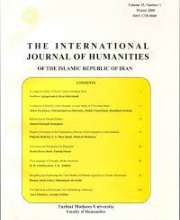۱.
Anahita, a prominent Zoroastrian goddess, has always had importance status and widely revered during the Sassanian period. In the present research, relying on the studies of Sassanian bas-reliefs and stuccos, an attempt has been made to study the role of this goddess in Sassanian art. The results of this research clearly indicate that Anahita, among the other Zoroastrian deities, has always had a valuable place in those eras because she was thought to offer wisdom to those who revered her. Personification and depiction of the goddess Anahita in human icons in Sassanian bas-reliefs and stuccos were an attempt by the Sassanian emperors to legitimize their rule.
۲.
The Holy Qur'an is the only revealed scripture that is immune of distortion, and includes the plan of human guidance, in all ages and for all individuals, whose verses must be comprehended accurately and correctly. This has proposed various exegetical theories by exegetes for many years. How can we provide a way to make these theories applicable, and determine a method to avoid them of engaging in interpretive relativity, interpretive pluralism, and even interpretive anarchism? Is it possible to provide such a model? Descriptive analytical procedure introduces the efficacy of an exegetical theory in terms of methodological criteria such as non-interference of exegete’s presumptions, the development of theories without the development of lexical meanings, the relation of language and culture of the time, the recognition of goals of verses and surahs, the identification of the outward and inward levels, etc. all lead to discover deeper levels of understanding of the Qur’an and result in quantitative and qualitative expansion of understanding the divine verses. It causes a valid and firm exegetical theory among others.
۳.
In this paper the author is attempting to assess both Islamism and Post-Islamism discourses and sees whether it is possible to talk about a Post-Islamist turn in the Muslim World, in general, and Iran, in particular. The author believes that we are still in an Islamist era but the challenges ahead belong to competitions between different approaches to Islamism rather than post-Islamist discourses. By arguing this, the author attempts to analyze how these competing discourses may affect the notion and locus of the state in Iran.
۴.
Since the outbreak of the COVID-19 pandemic in 2020 up to at least the beginning of 2022, e-learning has largely replaced the face-to-face teaching method in Iran. Accepting web-based learning could be effective in the continuity of this method, at least in a hybrid one, even in normal circumstances. As such, the role of teachers’ perspectives in this regard should not be neglected. Due to the importance of this kind of technology in teaching a second language and the effect of teacher acceptance on the decision to use it, in this study, we examine 63 Persian as a Second language (PSL) teachers' acceptance of Web-based e-learning technology to explore the various factors that impact their intentions to use it. This study uses the Technology Acceptance Model (TAM) as the theoretical foundation. The survey data obtained from 63 PSL teachers through previously tested and validated questionnaires are analyzed using Structural Equation Modeling with AMOS. The results suggest that the perceived usefulness (PU) directly impacts behavioral intention (BI). Then, there is the motivation to use (MU) construct and the perceived ease of use (PEU), which could indirectly affect BI. The Internet self-efficacy (ISE) construct directly affects BI. Finally, the factor of computer anxiety has a negative effect on behavioral intentions to use web-based E-learning technologies through the factor of perceived ease of use. The research results show that perceived usefulness is the most influential factor in PSL teachers’ intention to use technology. It implies that PSL teachers would be more likely to continue to use Web-based E-learning technologies if they consider them useful.
۵.
In Postcolonialism the issue of the influential power of dominant hegemony over the resultants of cultural confrontation between colonized and colonizer is preponderantly under scrutiny. Frantz Fanon is an influential figure in building upon this conceptual framework; whose oeuvre is bestrewed with postulations regarding the consequences of colonization and racism on the identity, experience, and the psyche of colored people. By utilizing Fanon’s thought, this paper intends to analyze different aspects of the black experience, such as alienation, inferiority, and assimilation in Edward P. Jones’s Pulitzer-winning novel, The Known World (2003). Throughout the novel, the conduct of free or bonded black characters within the institution of slavery reflects that of the white culture, and Fanon’s ideas are called upon to investigate the origin and possible consequence and implications of such behaviors.
۶.
After losing the Battle of Chaldiran, the Safavid administration had a difficult time in integrating the al-Tawaifi court system under the central authority. Feudalism of Shah Ismail was able to subjugate the local authorities and unify a portion of Iran's territory with the help of the Qizilbash force. Due to territorial and theological disputes, the Safavids and two Ottoman and Uzbek kingdoms engaged in several conflicts as a result of making Shīʿīsm as official faith in Iran. Following the Safavids' loss at Chaldiran, centrifugal (local) forces became more powerful and eclipsed the influence of numerous rulers. The Safavid era turned out to be significant historically. The study's findings indicate that the central Safavid government faced a significant challenge in concentrating power following the defeat at Chaldiran, and this challenge persisted with only a minor variation during later kings until the end of Mohammad Khodabande's reign.
